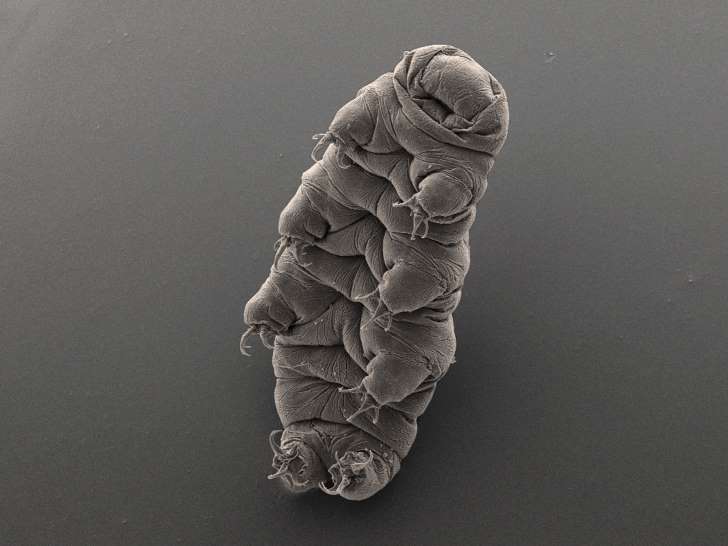February 18, 2016
The itty bitty water bears were lying in some frozen moss when a team of Japanese researchers discovered them on a trip to the Antarctic back in 1983. But rather than warming up the creatures, called tardigrades, the scientists locked them in a box of ice, shipped them back to Japan and stuck them in a lab for more than thirty years.

February 18, 2016
The itty bitty water bears were lying in some frozen moss when a team of Japanese researchers discovered them on a trip to the Antarctic back in 1983. But rather than warming up the creatures, called tardigrades, the scientists locked them in a box of ice, shipped them back to Japan and stuck them in a lab for more than thirty years.

An electron microscope image of “tardigrade” also known as a water bear, taken at UNC Chapel Hill in North Carolina.
The nerve.
No matter, though. It takes more than a few decades stored at subzero temperatures (-20º C, to be exact) in order to knock out a tardigrade. So, just one day after a separate team finally pulled the microorganisms out of their frozen cell in 2014, poking them with pipettes and soaking them in a nice nutrient bath, one of them started wiggling its legs.
Before long, the tardigrade — which the researchers named “Sleeping Beauty 1″ was scampering around its petri dish, even laying eggs. Meanwhile, a second tardigrade (“Sleeping Beauty 2″) began to revive, while an egg that had been found alongside them started to hatch, the scientists reported this week in the journal Cryobiology.
Dig ’em up, freeze ’em, abandon ’em for a generation — tardigrades can take it all. The cockroach wishes it was this sturdy.
These indestructible creatures — known as “water bears” but more closely resembling a cross between a caterpillar, a hippopotamus and Jabba the Hut — are the latest darlings of the biology world. They’re so adored that a group of University of North Carolina researchers launched an International Society of Tardigrade Hunters last year to seek out new species of tardigrade and promote appreciation of them among the general public, and the American Museum of Natural History in New York built a 10-foot replica of one to float above an exhibit on nature’s most resilient creatures.
If a funny-looking microorganism seems like an odd poster child for the wonders of nature, well, then, you probably haven’t heard a long enough list of all the ridiculous things they can do.
Tardigrades have been found in the most far flung corners of the planet, resisting whatever unbearable conditions the world might throw at them. They live in the airless extremes of the high Himalayas, the ice of the Antarctic, deep sea trenches, the dubious waters of a pond in New York’s Central Park. (They also live in pretty mundane places: dirt, moss, dust from the street.)
And that’s nothing compared to the indignities to which scientists have subjected them: starving them, squishing them, burning them, blasting them with radiation, drying them out and then rehydrating them like a packet of ramen noodles, even rocketing them into the frozen vacuum of space.
“They are probably the most extreme survivors that we know of among animals,” Bob Goldstein, a biologist at UNC Chapel Hill, told Wired in 2014.
Plus, they’re fairly cute: half a millimeter long (small enough to fit on the period at the end of this sentence) and roly-poly shaped, with eight stubby legs and a squashed face. Unlike most other invertebrates, which tend to dart about frenetically, tardigrades are amblers — their name is Latin for “slow stepper.” Their anatomy is also a scaled down, simplified replica of what’s found in larger animals, writes Baker University biologist William Miller for the American Scientist, which makes them ideal teaching tools. At one point, researchers thought the creatures would be the main model organism for studies of development — though that honor now lies with C. elegans, or roundworms, a staple of college biology classrooms.
But the tardigrade still holds its own. In this latest study, the creatures more than tripled their species’ previous record for survival in a cryogenic stasis (take that, C. elegens) — eight years for adult animals, nine years for their eggs. It was thought that 10 years might be the upper limit for survival in this sort of state, the researchers wrote; at some point, the cells would begin to break down.
But a combination of optimal storage conditions and the tardigrades’ incredible resilience enabled the creatures to survive 31 years encased in ice relatively unscathed.
The secret to their success rests in their ability to enter a state called cryptobiosis, in which their metabolism grinds to a standstill, Miller wrote. For all practical purposes, they’re pretty much dead.
But this is actually a survival mechanism for the dirt-dwelling creatures, which require a thin film of water around them at all times. If their conditions get too dry, the creatures will lose 97 percent of their body moisture and shrink to less than 40 percent of their full size, becoming desiccated husks of their former selves. In this cryptobiotic state, the animals can survive just about anything. Their cells become impervious to heat, cold, some radiation, extreme pressure (or lack thereof). From there it’s just a waiting game, the dried-out creatures (called “tuns”) biding their time until their conditions are wet enough to resurrect themselves.
That’s what happened when the Japanese researchers thawed out the frozen tardigrades they’d taken from the Antarctic. Just two of the creatures were able to return from the dead when the scientists tried to revive them — several others were found stretched out in the characteristic tardigrade deathbed pose. And although Sleeping Beauty 2 died after two weeks, her companion lived long enough to hatch 14 eggs. A tardigrade born from a revived egg that was found with them also lived and gave birth to young of its own.
The scientists now aim to figure out how the creatures were able to live so long, lead author Megumu Tsujimto said in a press release, by studying the damage to the tardigrades’ DNA and how they were able to repair it.
Courtesy: Washington Post












































































































